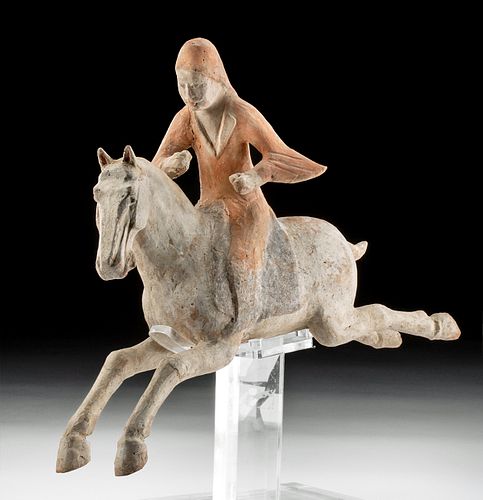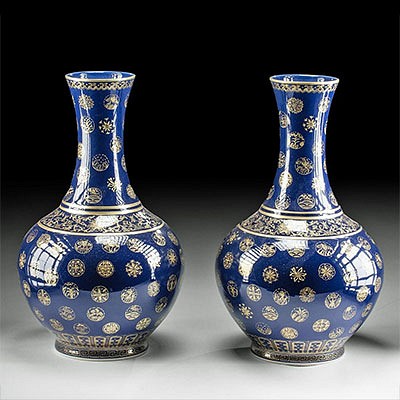Chinese Tang Dynasty Pottery Polo Player w/ TL Test
Lot 3
About Seller
Artemis Fine Arts
686 S Taylor Ave, Ste 106
Louisville, CO 80027
United States
Selling antiquities, ancient and ethnographic art online since 1993, Artemis Gallery specializes in Classical Antiquities (Egyptian, Greek, Roman, Near Eastern), Asian, Pre-Columbian, African / Tribal / Oceanographic art. Our extensive inventory includes pottery, stone, metal, wood, glass and textil...Read more
Categories
Estimate:
$4,500 - $6,500
Absentee vs Live bid
Two ways to bid:
- Leave a max absentee bid and the platform will bid on your behalf up to your maximum bid during the live auction.
- Bid live during the auction and your bids will be submitted real-time to the auctioneer.
Bid Increments
| Price | Bid Increment |
|---|---|
| $0 | $25 |
| $300 | $50 |
| $1,000 | $100 |
| $2,000 | $250 |
| $5,000 | $500 |
| $10,000 | $1,000 |
| $20,000 | $2,500 |
| $50,000 | $5,000 |
| $100,000 | $10,000 |
| $200,000 | $20,000 |
About Auction
By Artemis Fine Arts
May 6, 2021
Set Reminder
2021-05-06 10:00:00
2021-05-06 10:00:00
America/New_York
Bidsquare
Bidsquare : Art of Asia | Antiquity to Present
https://www.bidsquare.com/auctions/artemis-gallery/art-of-asia-antiquity-to-present-6908
Featuring antiquities and works of art ranging from the third millennium BCE to the present. From West to East including the Near East and Central Asia, China, Japan, Korea and South and Southeast Asia. Including jades, bronzes, lacquer, textiles, paintings, prints, sculpture, ceramics, more! Artemis Fine Arts info@artemisgallery.com
Featuring antiquities and works of art ranging from the third millennium BCE to the present. From West to East including the Near East and Central Asia, China, Japan, Korea and South and Southeast Asia. Including jades, bronzes, lacquer, textiles, paintings, prints, sculpture, ceramics, more! Artemis Fine Arts info@artemisgallery.com
- Lot Description
East Asia, China, Tang Dynasty, ca. 618 to 907 CE. An exemplary pottery polo player with a well-modeled figure upon a galloping horse with finely painted details and nice remaining pigments of orange, beige, white, and black. The sculpture emphasizes a powerful sense of movement and athletic balance. Note how the horse’s legs are extended front and back - a pose known as ventre a terre - while the rider leans forward, bending both arms at the elbow with hands clenched in fists, demonstrating intense focus. The player's bellowing sleeves sway in the wind, giving the impression of quick movement, while a veil caps the head. Size: 12.75" L x 3.25" W x 11.125" H (32.4 cm x 8.3 cm x 28.3 cm); 13.5" H (34.3 cm) on included custom stand.
While a 3rd century CE poem by the Chinese poet Cao Zhi mentions the act of hitting a ball on horseback, and a mural in the late 6th century tomb of Xu Minxing in Shandong province depicts a man mounting a horse while holding what look like polo sticks, the first very clear written evidence of the game of polo in China dates to the Tang dynasty, when the game was called jiqiu (meaning strike ball). In the present day, the game is usually called maqiu horse ball) or damaqiu (strike horse ball). Both men and women of the Tang court played polo. Two Tang emperors in particular, Taizong (reigned 626-649 CE) and Xuanzong (reigned 712-756 CE) favored the game of polo. They encouraged young men of the court to play it, because the skills involved could be applied to military activities.
Tang dynasty poets were also inspired by polo. The literatus Han Yu wrote a poem entitled Poem to Commander Zhang at the meeting of the Bian and Si Rivers" which describes a polo field that was 1000 steps long, with low walls on three sides, and called the ball used in the game "the divine bead". The poem describes the game occurring before sunrise on a cold autumn morning; drums making a thunderous sound when the red flags are raised to start the match; as well as the intense competition between the players and the excitement of the spectators. At the end of the poem, Han Yu declares that polo is not a game for mere fun, but is actually one devised for military training. This said, scholars also played polo during the Tang dynasty and successful candidates in the national civil service examinations held a polo tournament to celebrate.
This piece has been tested using thermoluminescence (TL) analysis and has been found to be ancient and of the period stated. A full report will accompany purchase.
This piece has been searched against the Art Loss Register database and has been cleared. The Art Loss Register maintains the world’s largest database of stolen art, collectibles, and antiques.
Provenance: private New Jersey, USA collection, acquired in 2016; ex-Anavian Gallery, New York City, New York, USA, acquired before 2010
All items legal to buy/sell under U.S. Statute covering cultural patrimony Code 2600, CHAPTER 14, and are guaranteed to be as described or your money back.
A Certificate of Authenticity will accompany all winning bids.
We ship worldwide and handle all shipping in-house for your convenience.
#163785Repaired from several pieces with restoration over some break lines and other break lines visible. A few stable hairline fissures. Expected nicks and abrasions, commensurate with age. Otherwise, excellent with impressive remaining pigments.Condition
- Shipping Info
-
All shipping is handled in-house for your convenience. Your invoice from Artemis Gallery will include shipping calculation instructions. If in doubt, please inquire BEFORE bidding for estimated shipping costs for individual items.
-
- Buyer's Premium



 EUR
EUR CAD
CAD AUD
AUD GBP
GBP MXN
MXN HKD
HKD CNY
CNY MYR
MYR SEK
SEK SGD
SGD CHF
CHF THB
THB













